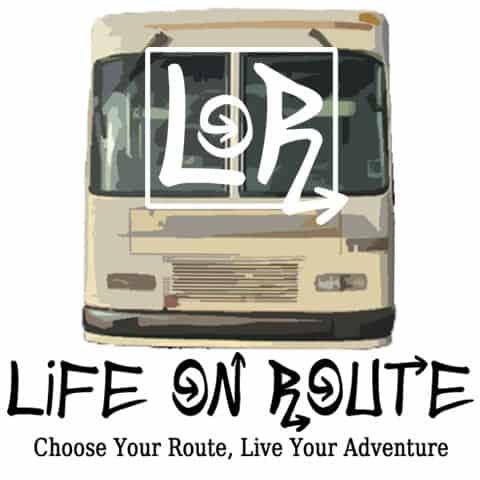This post contains affiliate links.
There is nothing more wonderful than driving down the road in an RV and looking for adventure with the family. You’ve loaded up your rig with food and gear and have the route all planned out. It’s a smooth ride down the scenic highways then comes the dreaded pop of your RV’s tire!
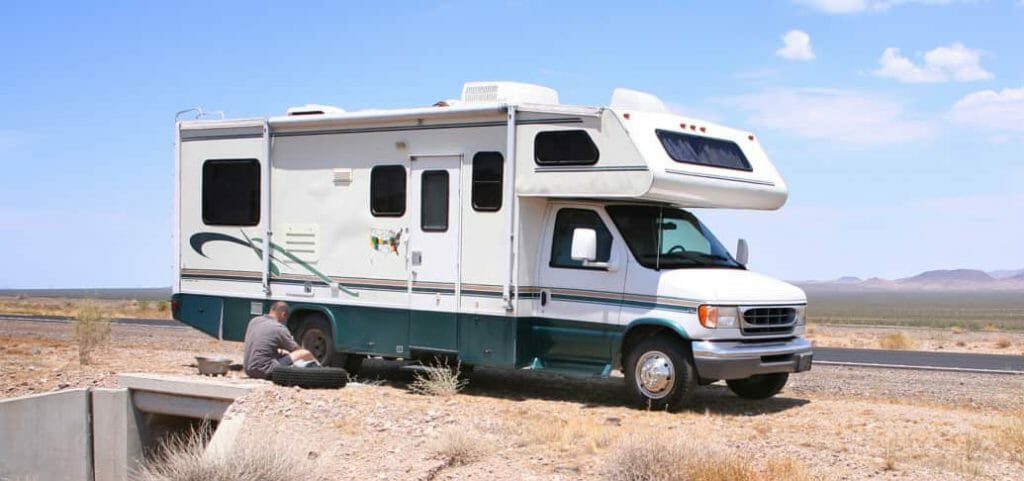
So why do RV tires blow out and how can you prevent it? RV tires blow out because of four crucial factors, including:
- Wear and tear causing tire damage
- Incorrect tire pressures
- Too much weight in and on the RV
- The tires were not replaced on schedule
Tire blowouts can be prevented by performing a few basic checks and some regular maintenance. Let’s go over all the details, a few may even surprise you!
Table of Contents
Wear and Tear Causing Tire Damage
While tire safety isn’t the most exciting topic relating to traveling in an RV, it is an essential topic to ensure you have the safest adventure possible. Following a quality checklist before and during travel will help guarantee you make it to your destination without any problems.
One vital step on every RV owner’s checklist must be a thorough inspection of the tires. A basic walk around of the RV that includes examining the condition of the tires will give you a heads up on whether the tires are up for another adventure or require some attention first.
Here is a list of the issues that can be spotted with a visual inspection and an explanation of each. They include:
- Checking the tire tread
- Looking for stress cracks and tread separation
- Checking for bubbling of the sidewalls
- Examining for Sun degradation
Checking the Tire Tread
Many tires have tread wear indicators or wear bars to let the owner of the RV know when it is time to get new tires.
A quick and easy way to check your tire tread depth is to take a penny and place it upside down into the tread. If the top of Abraham Lincoln’s head is totally visible you are below 2/32” of tread and new tires are required.
Of course, doing a quick check with an inexpensive digital tire tread depth gauge like this one from Amazon is much more effective.
Be sure to perform the check in a couple of different locations around the tire and in each groove from inside to out. Uneven wear can cause the tread depth to differ from one side to another.
If you suspect your tread is worn down too low to be safe, it is best to get a second opinion from a specialist. They will be able to answer any question regarding the condition of the tire treads.
Look for Stress Cracks and Tread Separation
Small hairline surface cracks will normally develop on the tire and are fine, but significant cracking along the edge of the tread on the outside of the tire is not.
It is common for tires to incur stress cracks from the everyday wear and tear they are put through. The cracks form as the bonding agent in the tire weakens over time. Exposure to gasoline, oil, and UV rays from the sun causes cracks to form along the sidewall.
The danger of these cracks is that they can suddenly expand, causing a tire blow out while driving down the road.
To protect RV tires from dangerous cracks, avoid using petroleum-based tire cleaning products when washing the tires. Instead, use plain soap and water which will not dry out the rubber material.
Check for Bubbling of the Sidewalls
The sidewall of a tire is the smooth face of the tire that connects the wheel rim to the tread. Tire bubbles are bulbous bulges that protrude from the sidewall of the tire. Flat tires from a bubble on the sidewall are far more serious than those caused by worn tread.
I had to learn this one the hard way. My RV sat in the Florida sun for far too long on very old tires before I bought it. The tread was good but I never noticed the bubbling sidewalls until it was too late. I ended up sitting on the side of the road for 6 hours waiting for a service truck to arrive.
Of course, my blowout happened in an area without cell phone service but I was lucky that I ended up right beside one of the few houses in the countryside. Lesson learned! Always check your tires before hitting the road!!
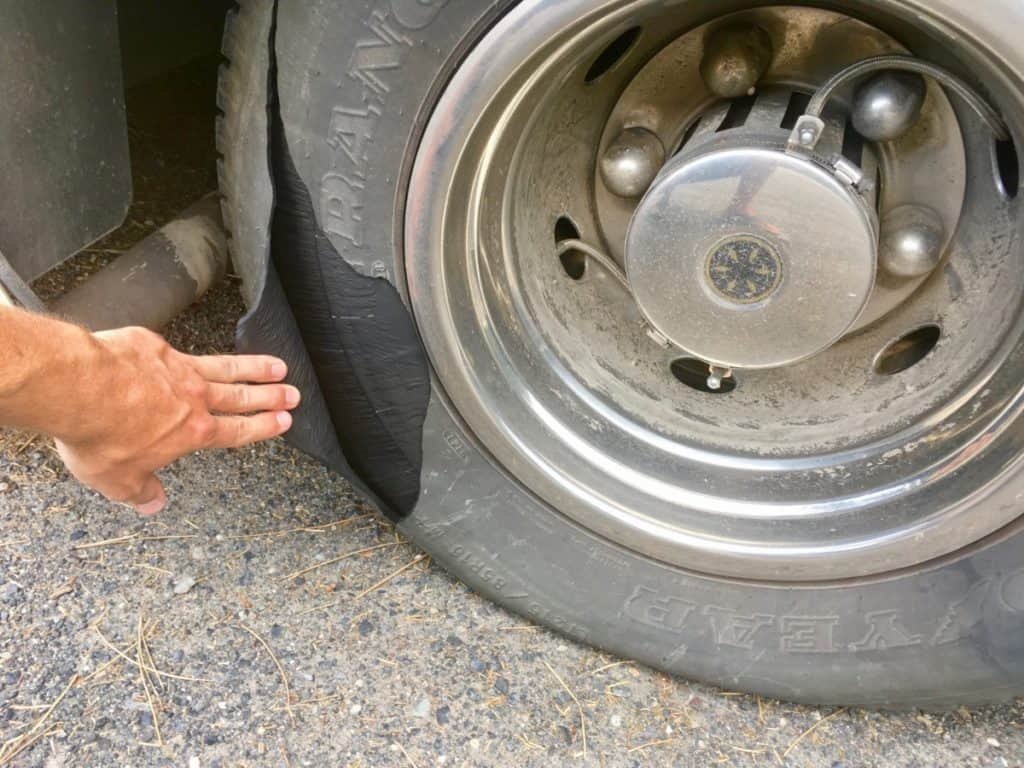
An RV tire, like most other tires, is manufactured with several different layers that can trap in tiny pockets of water. The accumulated water will eventually become a visible bubble. Air leaks from inside the tire to the outer layers can also cause bubbles to form on the sidewall of an RV tire.
If too much pressure builds up inside the bubble, it will burst, and a dangerous tire blowout occurs. The popping of a sidewall bubble can be caused by:
- Rubbing the tire sidewall against a curb
- Hitting potholes
- Driving too fast over speed bumps
- Rough railroad crossings
- Hitting debris on the road
- Tire overheating causing expansion
When damage occurs and causes a bubble to form, it is vital to replace the tire at once. Bubbled tires are not repairable but are an accident waiting to happen.
Checking for Sun Degradation
Many tire manufacturers claim that RV tires can last a maximum of ten years, however, if the tire is subjected to rubber degradation riding on them is dangerous. Most RV tire degradation comes in the form of dry rot.
Dry rot happens from lack of use and exposure to the sun and other environmental stressors while the RV is setting in the driveway. Other causes of dry rot are tire pressures below that suggested by the manufacturer of the tire.
To prevent dry rot, keep the tires covered from direct sunlight while the RV is sitting for any length of time. Also, be sure to check they are at the appropriate tire pressure at all times. You can get a set of 4 for less than $30 on Amazon which will save you from having to spend thousands on new tires.
Learn more about why covering your RV tires is important in our article Why You Should Cover Your RV Tires.
If you don’t use your RV on a regular basis and it does a lot of sitting around, you should at least roll it forward or back a half tire turn every month or two. This will help to distribute the load to different sides of the tire. Better yet, take it for a short drive to exercise the tires and prevent dry rot from occurring.
Inappropriate Tire Pressures
Whether your RV is driving around or sitting having low tire pressure has bad consequences. In fact, low tire pressure is more dangerous than high pressure because low inflation pressure causes your tires to overheat which leads to dangerous blowouts. However, both too high or too low of a tire pressure is not a good situation. You should always aim to maintain optimum tire pressures at all times.
To find the appropriate tire pressure for your tires check the owner’s manual of your RV. The tire pressure values are normally near the back but scanning the table of contents will point you to them.
Also, look at the sidewall of the tire to see what the maximum allowable pressure is so that you don’t exceed it. The max pressure written on the tire’s sidewall is usually for a cold tire so be sure to take that into account when you are measuring or filling them.
Visiting the website of the tire manufacturer will help determine the proper inflation pressure of the tire if you’ve lost the manual and the sidewall is unreadable.
If the pressure isn’t correct, air can be added by using an air compressor or some can be removed by carefully releasing the access air by pressing the needle in the valve stem.
I found these awesome tire pressure monitoring valve caps on amazon that change color if the pressure in my RV tire is too low. They are calibrated for my specific tire pressure and give me a quick visual indication during my morning walk around. They are super simple and save a lot of time.
Tip: Only inflate RV tires when they are cold, (not being used), to reach the correct air pressure as the air in a warm tire expands and can cause an incorrect reading. Learn my tips for easily inflating dual RV tires in my article.
Overloading Your RV
Knowing the weight limits of an RV is important to prevent damage to the tires as overloaded tires will squat, making them vulnerable to bulges, bubbles, and blowouts. While RVs are large, they still have a max weight limit.
The maximum allowable weight that your RV can handle will be specified in your owners manual as the Gross Vehicle Weight Rating (GVWR). You can also get the information online or by contacting the manufacturer of your RV.
Once you know the maximum allowable weight you can load up your rig with the gear you would normally bring along on your trip and head to a scale. Heavy duty truck scales are sometimes available at highway truck stops but it’s likely there are other locations in your town that have a scale.
Weighing your rig will cost you a little money but ensuring you’re not overloaded will save you on wear and tear in the long run. It will also create a much safer driving experience for you and your family.
Some scales will show you a total weight while others are able to show the weight distributed across each individual tire separately. Knowing your weight distribution across your 4 tires will help you rebalance for smoother handling and more even tire wear.
GAW And GAWR – Gross Axle Weight and Rating
The Gross Axle Weight Rating (GAWR) is the maximum weight that your RV axles can handle over each axle. It is usually divided into front and rear GAWR and is carried directly by your tires.
The GAW is a measure of the actual weight being supported by each axle. This is usually written as a dry weight in your owner’s manual which is the weight of the RV without any oil, water, coolant cargo, passengers, or fuel.
The “curb” GAW is the weight of the RV with everything inside the RV, including all the things taken out for dry weight. The curb GAW is the measurement that you will get by visiting a truck scale that measures the axle loads independently.
Too much weight improperly distributed over a single axle puts a lot of stress on your tires and can cause them to blowout.
The Tongue Weight
Pulling a trailer that is too heavy will cause excess wear on your RV’s tires. Always ensure that the tongue weight of anything you are towing does not exceed the maximum tongue weight rating of your vehicle. Serious tire damage can occur if it does.
The Gross Vehicle Weight Rating (GVWR)
The gross vehicle weight rating is the maximum combined GAW’s. The GVWR is typically displayed on a placard inside the RV.
Exceeding the vehicle’s gross vehicle weight is a recipe for RV tire damage.
When to Replace RV Tires
RV tires are quite expensive due to their size and weight carrying capacity. This cost is a major investment but replacing them proactively is much better than spending your vacation on the side of the road.
For help on replacing your RV tires, head over to our buyer’s guide, How to Choose RV Tires.
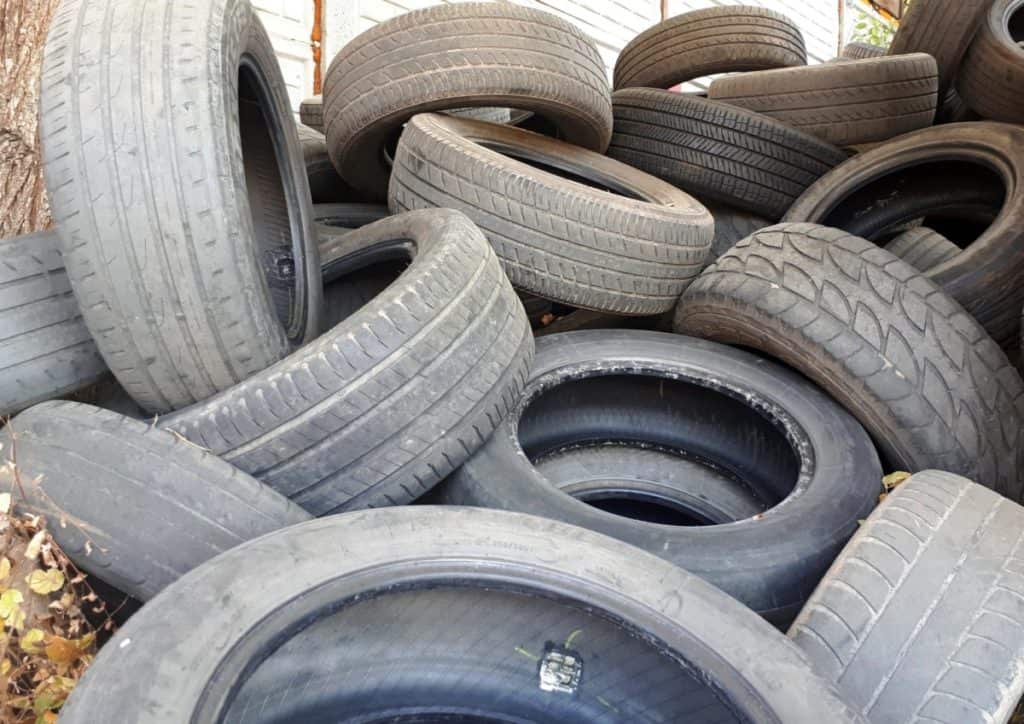
When tires are found to be unfit, it is important to exchange them for new ones. We’ve already discussed some of the warning signs such as bubbling and bulges but there are other reasons to think about buying new RV tires including:
- The overall age of the tires
- The tire wear pattern
- The Length of the Trip Being Planned
All three reasons taken together should give you an indication of whether the tires on an RV are safe for the next trip.
The Age Of Your RV Tires
The age of your RV tires is an important thing to know. The common rule is that RV tires need replacing every three to six years, depending on the usage the RV has seen.
However, if the RV has seen a lot of miles, the six-year mark will not be the rule because heavy usage shortens the life of the tire. The same is true of tires on an RV that has sat idle for a prolonged period of time.
The Way the Tires Have Worn
Always take into consideration how the tires on an RV look regardless of how long they have been in use. If they have worn unevenly or have little tread left, change those tires before hitting the road for a vacation.
No matter how old the tires are if they show wear that seems to indicate they are on their last mile, change them immediately.
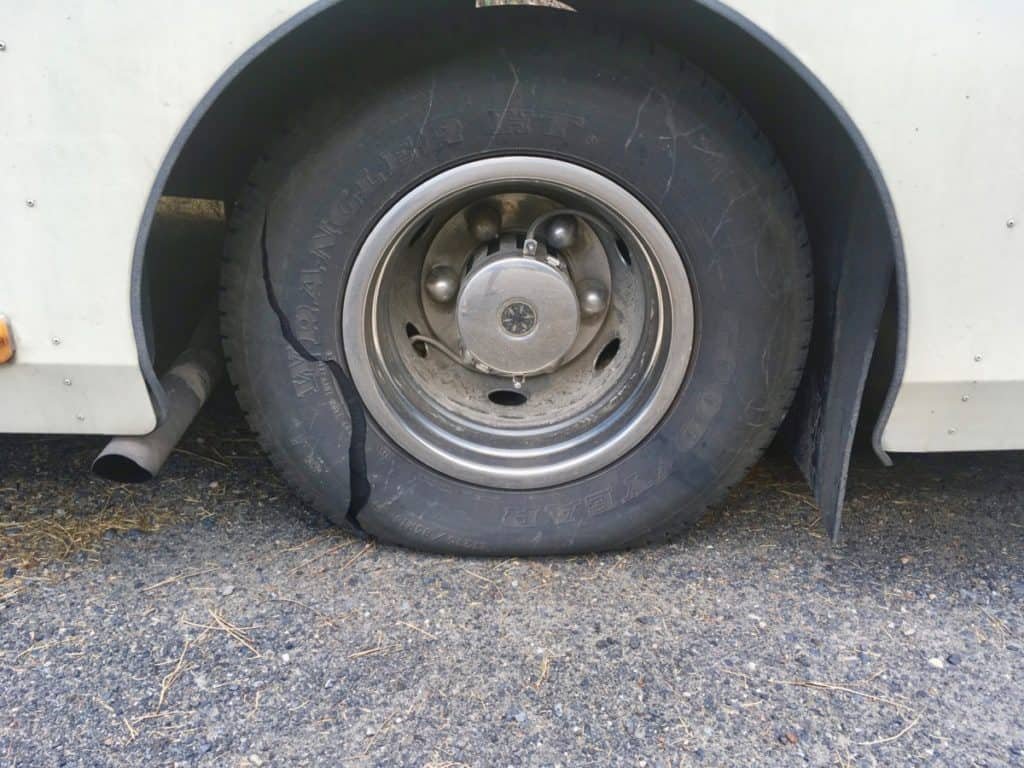
The Length of the Trip Being Planned
An important consideration is the distance you plan of traveling during your upcoming trip. If planning an extended vacation, then remember the tires on the RV will wear more while on the road. However, if the trip is a short weekend trip, changing the tires upon arrival back at home may be acceptable.
Most blowouts occur because the RV owner hasn’t paid close enough attention to the condition of their tires. To prevent blowouts follow the safety instructions in this article as well as those suggested by the RV and tire manufacturers.
The Importance of Realigning the Tires on an RV
Realigning the tires on the RV is critical for optimum position and maximum tire performance. Keeping tires aligned helps them track the road surface better and causes them to have longer lives and have better traction.
Realignment works by adjusting the toe-in, which is described as the front of your tires pointing slightly inward while toe-out is when the wheels are pointing slightly outward.
Excessive toe-in or toe-out causes scrubbing of the tires making the tires smooth on one side. A proper toe adjustment will give a driver better control behind the wheel and prevent uneven wear of your tire treads.
Tire Rotation is Crucial
Tires rotate all the time as they spin going down the highway, but rotating tires means something different entirely. Rotating the tires on an RV means moving them from inner to outer, from left to right, back to front or diagonally.
The reason rotating RV tires is so important is that the high vehicle weight causes the front tires to wear on the outside edges when turning corners. The rear tires usually wear more evenly, but because they are the drive tires it is wise to have them rotated as well.
If the tires are left in place, the outside edges on the front tires will wear down much faster than the others, and they will need replacing sooner. Rotating the tires on an RV also makes the handling of the RV safer and the ride smoother.
Load Distribution Safety for an RV
Proper load distribution makes handling the RV much better. However, the cargo has a tendency to shift which can cause the tires to blow out or go flat due to the uneven load.
There are four vital weight tips to remember:
- Keep cargo and weight evenly spaced
- Keep the cargo secured to prevent shifting and sliding
- Keep the center of gravity low and set the tire pressure properly
Following these tips and the others listed below will assist in avoiding problems with handling, braking, and bursting of tires.
Do Not Overload the Coach
RVs are rated for maximum loads that the vehicle was designed to carry. To find the load limit, check the manufacturer’s placard near the driver’s seat or the owner’s manual. This will tell you how much weight the RV can safely haul.
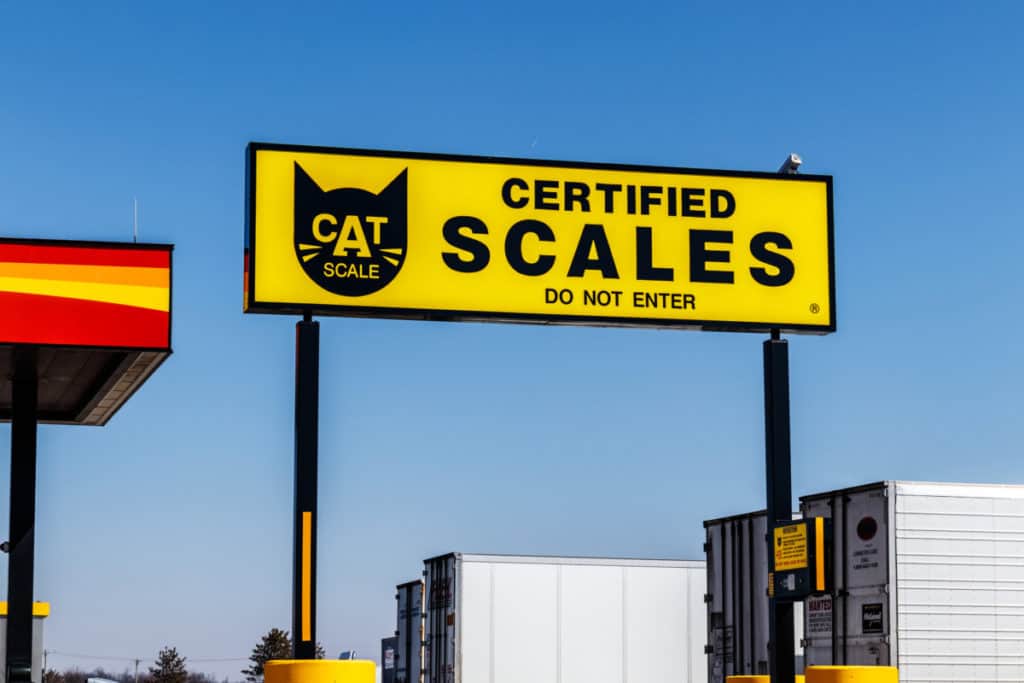
To measure how much weight the RV is carrying, go to a truck stop, and they’ll give you a weight slip for a small fee telling the total weight per axle. Alternately, an RV can go to a professional weighing agency to make sure it is not overweight on the corners or axles.
For motorized RVs, it is recommended that the front axle measure at 33-35% of the total weight being hauled.
The danger of an overweight load is that it affects the handling of the RV as it travels down the road, especially during windy conditions. If the wind blows on an RV that is not evenly loaded, it could cause the vehicle to sway or even leave the roadway.
Balancing the Load
Not only is the weight of the load vital but also the balance. By evenly spacing and balancing the load inside an RV, the maneuverability of the RV in traffic will be greatly enhanced. Unbalanced lightweight on the front of the RV places excessive weight on the back of the vehicle and raises the front of it making steering control and braking difficult.
Proper weight balance of a travel trailer is also important. An unlevel trailer can lead to uneven tire wear. Learn more in our article Should a Trailer Be Level When Towing?
Finding and Buying Tires for an RV
Although finding the correct tires for an RV can be very frustrating, a little research can save a lot of money.
The best place to begin is to read the manual that came with the RV as it will give vital information about what tires are right for that particular model. The manual should contain the recommended size, weight ratings, sidewall strength, and load rating for the RV.
Other considerations when buying RV tires are:
- Maximum weight limits of each
- The terrain that will be traveled
- The weight of the load that will be hauled
- The climate (hot or cold) the RV will travel through
Each tire manufacturer has a chart that reveals the sizes and variations of RV tires they make. Buying an RV tire that is too small or too large is dangerous as it will not carry the weight of the load well.
Do not use generic tire brand charts as they may be inaccurate. When in doubt, contact your local tire shop and ask for recommendations.
Tires Determine The Quality and Safety of the Ride
Some tires can handle the rough terrain of a back road in the wild better than others. There will be a trade off between road noise and tread styles between highway and offroad tires.
If the tires are too small for the RV in question, the ride will become rough even on the open highway and are extremely dangerous because of the possibility of a blowout. If the tires are too large, they tend to wear unevenly which can also cause a blowout.
Cheaper, discounted tires may seem good from the perspective of the pocketbook of an RV owner but they are fraught with danger. That being said, sometimes well-known tire manufacturers such as Goodyear perform recalls for tires that are defective as well.
The bottom line is that the tires under the RV are the most important equipment on the vehicle and need constant and vigilant care to make sure a trip or vacation remains safe and happy.
How to Change a Flat on an RV
Should the unthinkable happen and a tire blows while traveling down the road, it is critical to understand how to safely change it.
The following discussion on how to change an RV tire is specific to those of a trailer, not for motorhomes. Motorhomes are much heavier and require specialized equipment to change tires. This should be reserved for a professional.
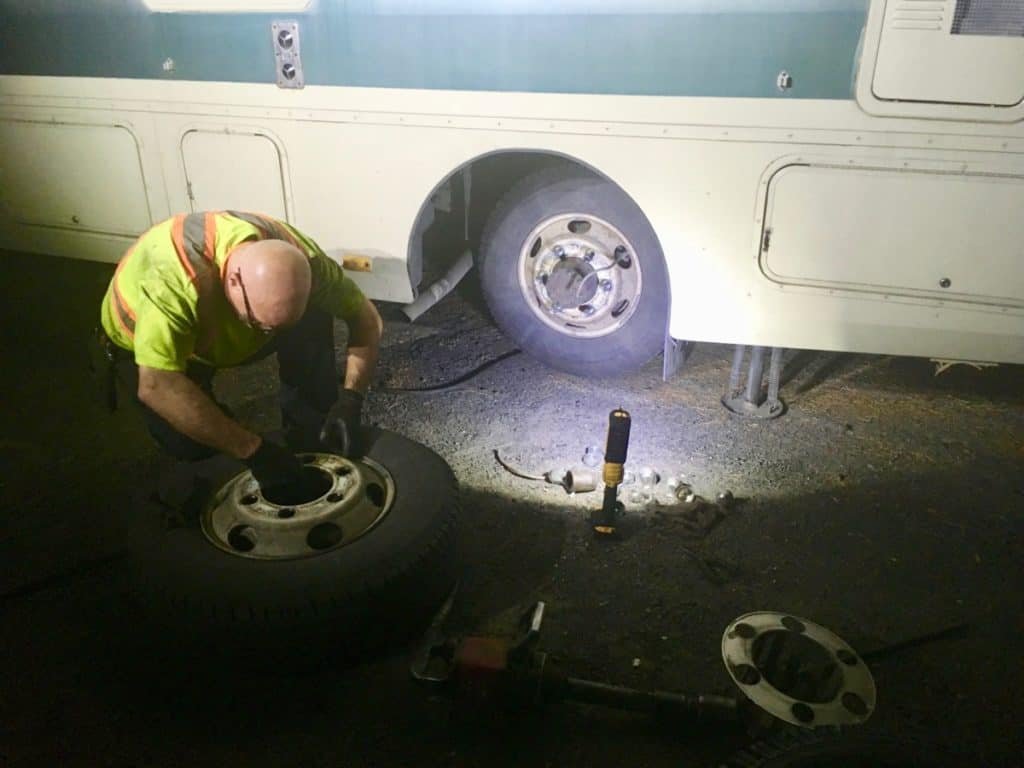
The first step in changing a tire happens before it goes flat or blows. Make sure there is a spare tire and some other equipment including:
- A jack to lift the trailer
- A tire wrench
- A small portable air compressor
- Work gloves
Before beginning any tire change on any vehicle, please, make sure the area you are working is safe. Try to avoid changing the tire on the RV on the side of an interstate or highway. It is not good to ride on the rim of a tire as the axle of the wheel can become bent, but attempting to change a tire on a busy interstate can become deadly.
Step 1: Loosen the lug nuts on the wheel slightly and raise the trailer up on the jack.
Step 2: Remove the lug nuts on the flat tire and replace it with the spare
Step 3: Replace the lug nuts and tighten until snug.
Step 4: Lower the jack and tighten the lug nuts again
Step 5: Inflate the new tire to the correct PSI using a tire gauge
Step 6: Replace the spare with a new or repaired regular tire as soon as possible
Note: Jacks are designed to be used for changing tires on a single axle trailer Trailers should only be jacked up from the points specified by the manufacturer.
In Closing
The tires on your RV are your connection to the road and the difference between a vacation and a disaster. Always pay close attention to the condition of your tires by inspecting them regularly.
Taking a proactive approach to avoiding the situations that cause most RV tire damage will save you a lot of time and money in the long run. Happy and safe travels!
